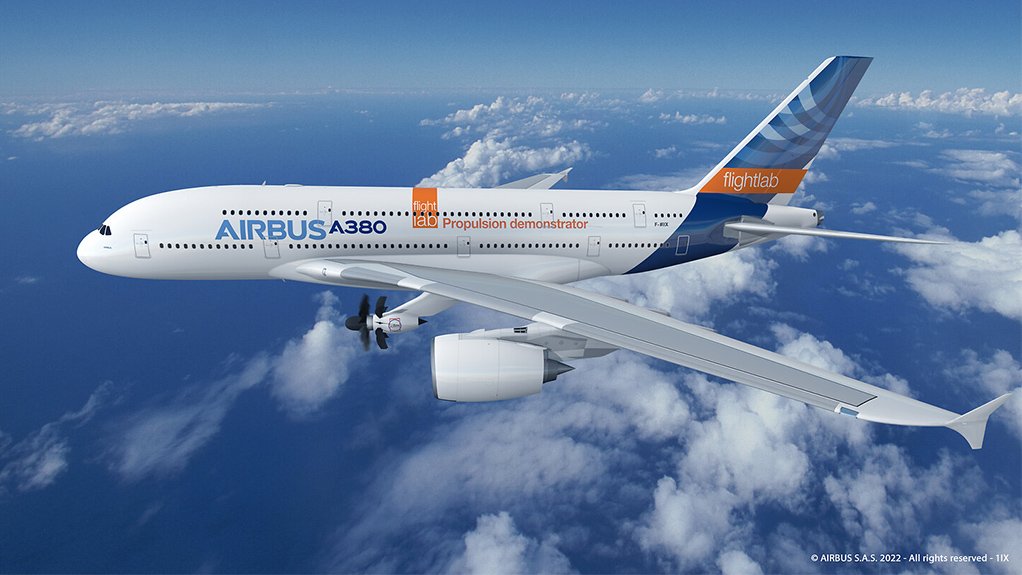Airbus and CFM team up to flight test a new and more efficient aeroengine design


Artist’s impression of the Airbus A380 flying test bed fitted with a CFM RISE engine
Photo by Airbus
Europe-based global major aerospace group Airbus, and international aeroengine company CFM International (a 50:50 joint venture between GE of the US and Safran Aircraft Engines of France) announced, at the Farnborough International Airshow on Tuesday, that they were collaborating to test, in flight, the leading-edge open fan engine architecture being developed by the latter. This will see the engine, developed under CFM’s Revolutionary Innovation for Sustainable Engine (RISE) programme, flown on a modified Airbus A380 Superjumbo, during the second half of this decade.
An open fan, or open rotor, engine, previously also known as an unducted fan or as a propfan, is related to the turbofan engines that today power the vast majority of the world’s jet aircraft, civil and military. But while the fan blades of a turbofan are contained within a nacelle, the fan blades in an open rotor design are ahead and outside of the engine nacelle, effectively acting as advanced-design propellors. But the core of the engine is the same type of gas turbine found in a turbofan. Ideally, the open fan should provide the fuel economy of the propellor-using turboprop (which the open fan resembles in appearance but not in its engineering) and the speed of a turbofan.
Open fan engines have been under consideration by various manufacturers since the early 1980s, if not even before that. However, the big problem until now has been the noise generated by open fans: unducted fan blades are much noisier than ducted fan blades.
The CFM RISE engine, however, takes a totally new approach to open fan design. Instead of the established concept of each open fan having two sets of contrarotating fan blades, RISE has a single set of rotating blades, backed up with a second set of fixed blades (more accurately, stationary outlet guide vanes). These allow the airflow to be directed and allow the engine to achieve speeds compatible with those delivered by turbofan engines.
Open fan engines reduce weight in comparison to turbofan engines, because they do not need nacelles for their fans, only for their turbine cores. Further, the RISE engine reduces the complexity of open fan designs. And the designers have significantly reduced the noise emitted by the engine to a level that is now certifiable by aviation regulators. (GE engineers have been working on open fan concepts for about 40 years now.)
Even using conventional Jet-A fuel, RISE promises to deliver a 20% decrease in carbon dioxide emissions compared with the most efficient engines in service today. Using sustainable aviation fuel (SAF), the reduction would be even greater. Confirming these benefits are among the objectives of the planned flight test campaign. Others include increasing understanding of the integration of the engine with the aircraft wing and the consequent aerodynamic performance; the engine’s compatibility with SAF; and establishing the noise levels actually emitted by the engine when it is operating on an aircraft. The flight test campaign will be conducted at Airbus’ Flight Test centre in Toulouse in France.
This is the second partnership between the two companies aimed at reducing aviation’s carbon emissions. In February, they announced a flight test project to validate the use of hydrogen as an aviation fuel.
Article Enquiry
Email Article
Save Article
Feedback
To advertise email advertising@creamermedia.co.za or click here
Comments
Press Office
Announcements
What's On
Subscribe to improve your user experience...
Option 1 (equivalent of R125 a month):
Receive a weekly copy of Creamer Media's Engineering News & Mining Weekly magazine
(print copy for those in South Africa and e-magazine for those outside of South Africa)
Receive daily email newsletters
Access to full search results
Access archive of magazine back copies
Access to Projects in Progress
Access to ONE Research Report of your choice in PDF format
Option 2 (equivalent of R375 a month):
All benefits from Option 1
PLUS
Access to Creamer Media's Research Channel Africa for ALL Research Reports, in PDF format, on various industrial and mining sectors
including Electricity; Water; Energy Transition; Hydrogen; Roads, Rail and Ports; Coal; Gold; Platinum; Battery Metals; etc.
Already a subscriber?
Forgotten your password?
Receive weekly copy of Creamer Media's Engineering News & Mining Weekly magazine (print copy for those in South Africa and e-magazine for those outside of South Africa)
➕
Recieve daily email newsletters
➕
Access to full search results
➕
Access archive of magazine back copies
➕
Access to Projects in Progress
➕
Access to ONE Research Report of your choice in PDF format
RESEARCH CHANNEL AFRICA
R4500 (equivalent of R375 a month)
SUBSCRIBEAll benefits from Option 1
➕
Access to Creamer Media's Research Channel Africa for ALL Research Reports on various industrial and mining sectors, in PDF format, including on:
Electricity
➕
Water
➕
Energy Transition
➕
Hydrogen
➕
Roads, Rail and Ports
➕
Coal
➕
Gold
➕
Platinum
➕
Battery Metals
➕
etc.
Receive all benefits from Option 1 or Option 2 delivered to numerous people at your company
➕
Multiple User names and Passwords for simultaneous log-ins
➕
Intranet integration access to all in your organisation

















